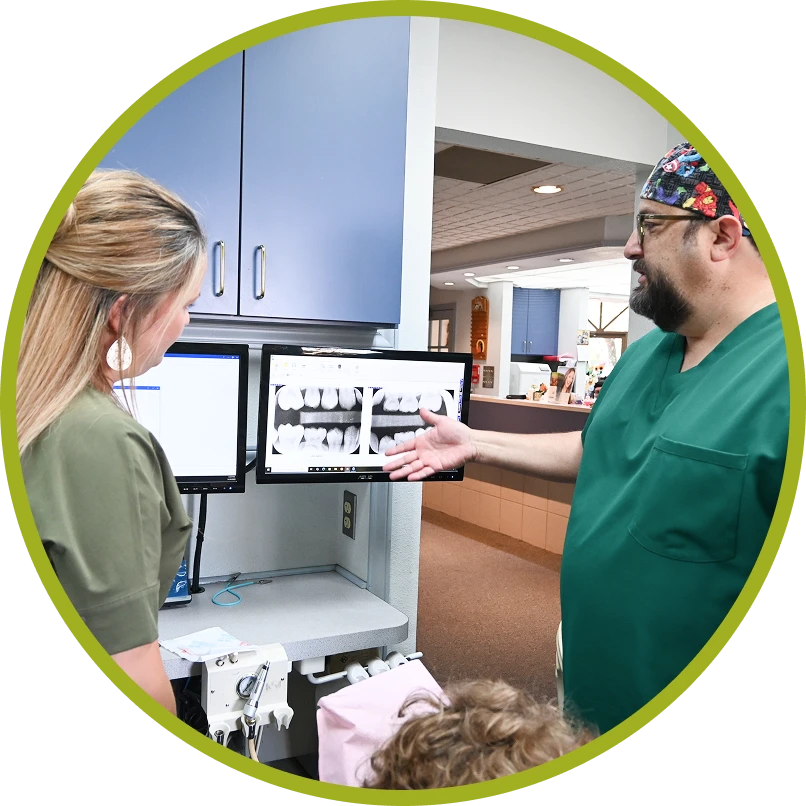Many parents have concerns about their child’s oral health and treatments. On this page is information related to concerns that our Dr. Derrick Cantu, Dr. Christi Wengler and our team encounter frequently. If you have additional concerns or questions, please call Pediatric Dentistry of San Antonio at 210-680-7841 and speak with a member of our team. We will be happy to provide you with more information and help you make an appointment with our pediatric dentists in San Antonio, Texas.
General Anesthesia
There are circumstances where a child’s treatment needs, anxiety levels and or fears exceed what is safe to be conducted in the office setting with other behavior guidance modifications. In these circumstances, it is the standard of care to treat a patient under a general anesthesia setting. Dr. Cantu and Dr. Wengler are board certified pediatric dentists who have active hospital privileges. If this is the mode of treatment that is necessary, your child will be treated at a Methodist outpatient facility or hospital depending on his or her medical history.
During general anesthesia treatment the anesthesia is administered by a medical anesthesiologist and a staff of registered nurses and anesthesia technologists. In most cases you and your patient will be released home the same day as the procedure. It is extremely important that at the dental appointment you provide a complete and updated medical history so we can make preparations to make this visit as safe and comfortable for you and your children as possible. Drs. Cantu and Wengler will be happy to discuss any questions over general anesthesia during your dental appointment. A general anesthesia consult can also be requested to have an undisturbed discussion without any distractions if desired.
Double Row of Teeth – Shark Teeth
We are often asked about kids growing teeth behind their baby teeth as shown in the photos below. This occurs because the permanent teeth form behind the roots of the baby teeth and sometimes they grow behind the baby tooth before it falls out. When this occurs, most the time no treatment is needed, nature usually takes care of the situation, but occasionally the baby tooth does have to be extracted (pulled). If your child has a permanent tooth growing behind the baby tooth do not panic, be patient; at the next regular check-up visit, an X-ray may be necessary to determine if any treatment is needed. If you are too concerned to wait for the regular check-up, call and make an appointment for a quick check of the situation. The chances of the tooth correcting on its own are great if there is room for the tooth to move forward (see the series of one child’s photos below). Unfortunately, in a crowded mouth without adequate space, only braces will straighten teeth, and generally braces should not be considered until the child is much older (around the age of 12). Options can be discussed the next time your child visits the dental office.






Lip Bite
We are asked occasionally about a white scab that sometimes a patient develops after treatment. Some parents confuse this for looking like a burn when it is really from the patient biting themselves while being numb. There is no treatment for this trauma other than time to allow it to heal.


My Child Has a Bruise on Their Gums?

This is not a bruise but something that is called an eruption cyst or a hematoma. This is a sack of fluid that the permanent tooth grows and develops in and occasionally will appear on the surface of the gums. There is usually no treatment that is needed and will burst when the permanent tooth grows in.
Erupting Molar

Sometimes the question arises and in a panic parents state that a tooth has broken off in their child’s mouth. If the tooth looks similar to the one in the picture the tooth is not broken but still erupting or growing in the mouth. This is a normal process that takes place as the tooth develops and will look normal once the tooth is fully in the mouth. New molars grow in the mouth around age 6, 12 and 18.
Fractured Tooth

Notice the three layers of the tooth shown in this picture and compare and make mention of the comparison when calling for your child’s emergency.



